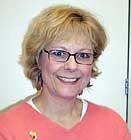 |
|
|
| Author |
Message |
Lisa
Guest

|
 Posted:
Fri Jun 11, 2004 4:16 am Posted:
Fri Jun 11, 2004 4:16 am |
  |
HI Karen,
Thanks for answering all of mine and my students' questions so thouroughly in your journal, my kids were surprised that I had questions too so it was good for them to see that even teachers wonder about things.
A few more... how do you keep track of your research? Do you keep a field notebook? (we're learning about those in a class I'm in) Also, to see how the tundra is changing over time do the scientists you work with come back and sample the same areas repeatedly?
Finally, I read somewhere that the tundra doesn't really have true soil, it's not like what we have here, what is it like? Are there rocks? Take care, enjoy your last week!
Lisa Hansen |
|
|
|
 |
Karen_Bejin

Joined: 23 Mar 2004
Posts: 118

|
 Posted:
Fri Jun 11, 2004 11:51 pm Posted:
Fri Jun 11, 2004 11:51 pm |
  |
I have to write a quick answer so I can get back out in the field for our 4:00 readings. You must have read my mind-or I read yours, because the sampling and recording of it is what I wrote about today in my journal. 1. We actually keep track of things in a couple ways. The data taken by many of the instruments is collected and then downloaded into a computer, either daily, or weekly for one of the instruments. Everything we work on out in the field, like the sampling, the permafrost depths, the voltage on the batteries that power the probes, the subterranian temps from the soil probes, etc, are recorded in a notebook. We also record data about each sample directly onto the cups. Data can never be logged too often. 2. Will we come back to repeat the tests? There are some experiments that have been going on each summer ffor more than 20 years. Many of the people here come up (or someone from their group) every summer. For our group, this is the 3rd or 4th place the radimeters have been used. When the data shows that they work well to collect information like this, they will be taken off the truck-just the radiometers, not the big antenna, and put on a satellite, which will then monitor the arctic continuously. 3. The soil is what is giving me troubles lately, and the rocks. In the tussock tundra we find the soil. It gets to be quite dense. In some areas like our shrub site it is difficult to find soil, mostly moss. And there are rocks of all sizes in the part in which I am trying to dig! As you travel around there are lots and lots rocks. There are also mountains and hills yet for many miles towards the north. How's your class? Got to go to work-Karen |
|
|
    |
 |
|
|
|
View next topic
View previous topic
You cannot post new topics in this forum
You cannot reply to topics in this forum
You cannot edit your posts in this forum
You cannot delete your posts in this forum
You cannot vote in polls in this forum
You cannot attach files in this forum
You can download files in this forum
|
Powered by phpBB 2.0.11
© 2001, 2002 phpBB Group :: FI Theme ::
All times are GMT
| |
